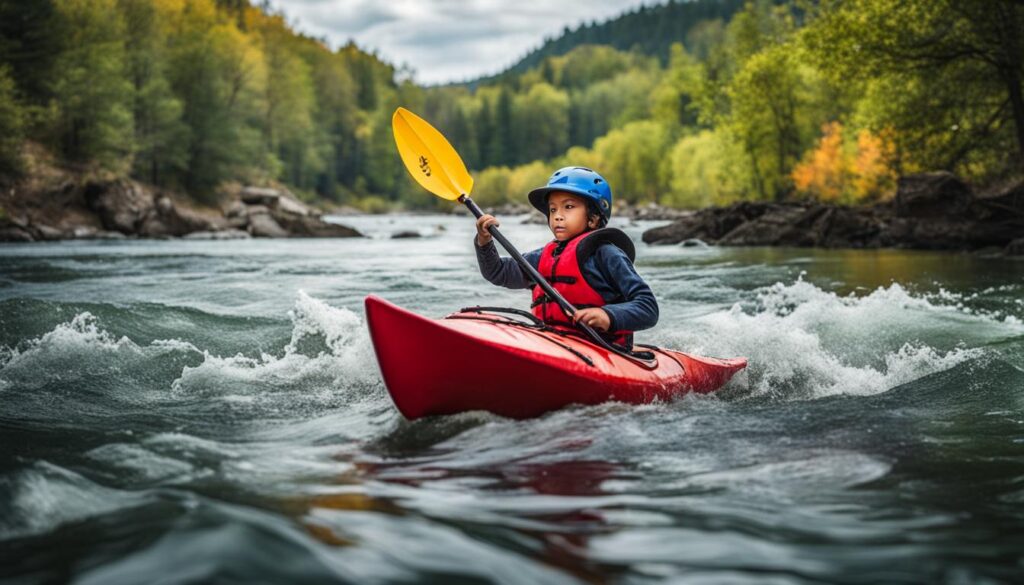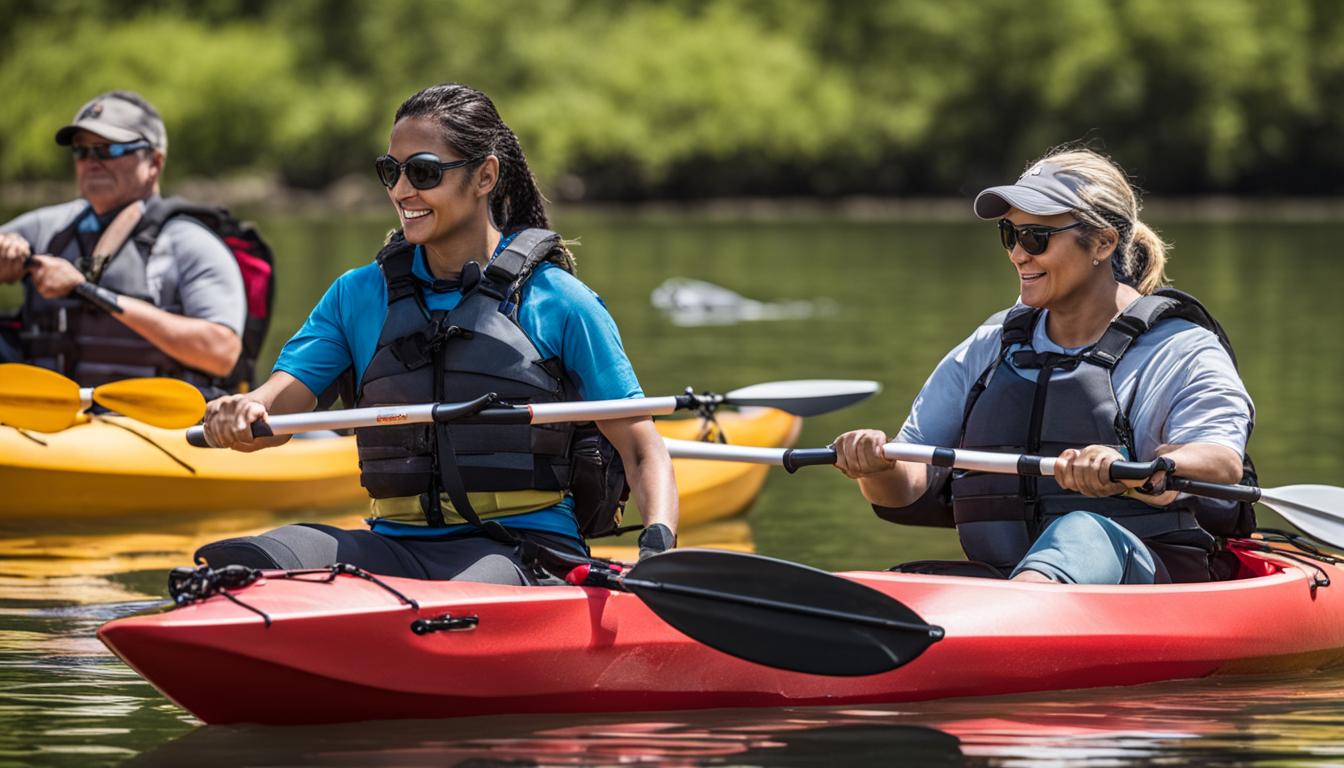Welcome to our article on how kayaking can benefit your child’s development. Kayaking is not only a thrilling water-based activity but also a wonderful way to enhance various aspects of your child’s growth. From physical fitness to mental well-being, let’s explore the numerous benefits that kayaking has to offer.
Key Takeaways
- Kayaking improves motor skills, balance, and coordination
- It promotes mental well-being and a connection with nature
- Kayaking enhances social skills, teamwork, and discipline
- Engaging in competitive kayaking develops cognitive skills
- Kayaking teaches water safety and provides opportunities for family bonding
What Is Kayaking?
Kayaking is a popular water-based activity that serves as an excellent physical activity for children. It involves the use of a small, narrow boat called a kayak and a double-bladed paddle to navigate through the water. As children paddle and maneuver their kayaks, they engage various muscles, improving their overall strength, endurance, and cardiovascular fitness.
Aside from its physical benefits, kayaking also offers opportunities for outdoor education. Children can learn about important safety measures to ensure a safe kayaking experience. They can also explore different paddling techniques and become familiar with the various types of kayaks designed specifically for kids. This exposure to outdoor education not only enhances their knowledge but also fosters a sense of adventure and appreciation for nature.

Overall, kayaking serves as an ideal physical activity for children, allowing them to develop their motor skills and enjoy the outdoors. It combines the excitement of exploration with the educational aspect of learning, making it a well-rounded experience for kids.
Nature Appreciation and Conservationism
Kayaking provides a unique opportunity for children to explore and appreciate nature from a different perspective. By paddling through waterways, they can access areas that are not easily reachable on foot, giving them a closer look at wildlife and ecosystems. This experience can nurture their connection with nature and instill a sense of wonder and respect for the environment.
Research has shown that spending time in nature has numerous mental health benefits for children. Engaging in outdoor activities like kayaking can reduce stress levels, improve mood, and enhance overall well-being. The tranquil and serene environment of the water allows kids to disconnect from screens and technology, fostering a sense of calm and tranquility.
Furthermore, kayaking can play a role in teaching children about the importance of conservationism. As they observe the beauty and fragility of ecosystems firsthand, they develop a deeper understanding of the need to protect and preserve the natural world. Kayaking can spark their curiosity and interest in environmental issues, inspiring them to become future advocates for conservation.
Table: Benefits of Kayaking for Kids’ Mental Health and Nature Appreciation
| Benefits | |
|---|---|
| 1 | Reduces stress and anxiety |
| 2 | Improves mood and overall well-being |
| 3 | Enhances connection with nature |
| 4 | Fosters sense of wonder and respect for the environment |
| 5 | Develops curiosity and interest in conservation |
By incorporating kayaking into a child’s routine, parents can help them develop a lifelong appreciation for nature and create positive memories associated with outdoor exploration. The close interaction with the natural world during kayaking adventures can have a profound impact on a child’s mental health, promoting relaxation, mindfulness, and a sense of connection to something greater than themselves.
Overall, nurturing children’s nature connection through kayaking not only benefits their mental health but also plays a vital role in fostering environmental consciousness. Encouraging their love for the outdoors and instilling a desire to protect and conserve the environment sets a foundation for them to become responsible stewards of the natural world.
Teamwork, Cooperation, and Discipline
Kayaking is not just an individual activity; it also offers valuable opportunities for teamwork, cooperation, and discipline. When children participate in kayaking as a team, they learn the importance of working together towards a common goal.
One of the key aspects of kayaking is paddling in sync with the rest of the team members to ensure smooth movement in the water. This requires effective communication, coordination, and cooperation. Children quickly realize that their actions directly impact the performance of the whole team, fostering a sense of responsibility and commitment.
Furthermore, kayaking can be challenging, especially for beginners. It requires discipline and perseverance to master the necessary skills and techniques. From learning how to paddle properly to navigating through different water conditions, children develop a sense of self-discipline and resilience. They understand the importance of practice, patience, and continuous improvement to achieve their goals.
Benefits of Teamwork, Cooperation, and Discipline
- Enhanced social skills: Working together in a team setting strengthens communication, cooperation, and problem-solving abilities, which are essential social skills.
- Improved self-discipline: Kayaking teaches children the importance of practice, perseverance, and continuous improvement, fostering self-discipline and determination.
- Healthy competition: Through kayaking, children learn how to handle competition in a positive way by developing good sportsmanship and resilience in both victory and defeat.
- Transferable skills: The qualities children learn through kayaking, such as teamwork and discipline, can be applied to various aspects of their lives, including academics and other extracurricular activities.
Overall, kayaking provides children with a unique platform to develop their teamwork, cooperation, and discipline skills. Whether they paddle with friends, family, or participate in organized kayaking events, the experience teaches them valuable life lessons that can shape their character and contribute to their personal growth.
Cognitive Development and the Impact of Kayaking on Children’s Growth
Kayaking offers more than just physical activity for children; it also plays a significant role in their cognitive development. Engaging in this water-based sport can have a positive impact on children’s overall growth, contributing to their mental abilities and problem-solving skills.
“Through kayaking, children learn to navigate and make decisions in changing environments, enhancing their cognitive flexibility and adaptability,” says Dr. Lisa Thompson, a child psychologist.
The dynamic nature of kayaking requires children to focus on their surroundings, assess risks, and make quick decisions. This active engagement enhances their ability to think critically, analyze situations, and develop problem-solving strategies. Additionally, the physical coordination required to maneuver a kayak stimulates brain activity, improving spatial awareness and hand-eye coordination.
In a society increasingly dominated by screens and indoor activities, kayaking provides a much-needed break and a chance for children to engage with the natural world. This exposure to nature has been shown to have a positive impact on cognitive development, reducing stress levels and improving attention span and memory retention.
The Benefits of Kayaking on Children’s Cognitive Development:
- Enhanced cognitive flexibility and adaptability
- Improved critical thinking and problem-solving skills
- Stimulated brain activity, improving spatial awareness and hand-eye coordination
- Reduced stress levels and improved attention span and memory retention
By incorporating kayaking into children’s activities, parents can support their cognitive growth, fostering their ability to think creatively, make decisions under pressure, and thrive in a rapidly changing world.
| Kayaking and Cognitive Development | Benefits |
|---|---|
| Enhanced cognitive flexibility and adaptability | Able to navigate and make decisions in changing environments |
| Improved problem-solving skills | Develop critical thinking abilities and analyze situations |
| Stimulated brain activity | Improved spatial awareness and hand-eye coordination |
| Reduced stress levels | Improved attention span and memory retention |

Kayaking: Water Safety and Family Bonding
Kayaking offers more than just physical activity and mental health benefits for children. It also serves as a valuable platform for teaching water safety and responsible behavior. By introducing children to kayaking, parents can instill important lessons about choosing appropriate locations, understanding weather conditions, and practicing safe behaviors while on the water. This knowledge not only ensures their well-being during kayaking adventures but also equips them with skills they can apply in other aquatic activities throughout their lives.
Besides its educational aspect, kayaking is also an excellent opportunity for families to bond and create lasting memories together. It provides a shared experience full of adventure and excitement, allowing family members to connect in a unique outdoor setting. Whether paddling through calm lakes or navigating gentle rivers, the whole family can enjoy the beauty of nature while engaging in a fun and active pastime. Kayaking as a family activity promotes physical fitness, mental well-being, and strengthens familial relationships.
Overall, kayaking serves as a multifaceted activity that benefits children in various ways. Not only does it provide physical exercise and mental health benefits, but it also teaches them about water safety and fosters family bonding. By incorporating kayaking into children’s lives, parents can encourage their growth, development, and love for outdoor adventure. So grab your paddles, gather your loved ones, and embark on a kayaking journey that combines learning, fun, and connection with nature.
Table: Water Safety Tips for Kayaking with Children
| Tip | Description |
|---|---|
| Choose Appropriate Locations | Select kayaking spots suitable for children, such as calm lakes or gentle rivers, to ensure a safe and enjoyable experience. |
| Check Weather Conditions | Always monitor weather forecasts before kayaking with children and avoid going out on the water during storms or inclement weather. |
| Wear Personal Flotation Devices (PFDs) | Make sure every child wears a properly fitting PFD while kayaking to ensure their safety in case of accidental capsizing or immersion in water. |
| Teach Basic Rescue Techniques | Equip children with basic rescue techniques, such as how to reenter a capsized kayak or how to assist others in need, to enhance their confidence and preparedness. |
| Supervise and Communicate | Always keep a close eye on children while kayaking, maintain verbal communication, and establish clear signals or calls for immediate attention or assistance. |
Conclusion
Kayaking provides numerous benefits for your child’s development, both physically and mentally. Engaging in this water-based activity helps improve their physical fitness, enhancing motor skills, balance, and coordination. Additionally, kayaking promotes mental well-being, allowing children to connect with nature and experience the positive impact on their mental health.
Aside from the physical and mental advantages, kayaking also contributes to your child’s cognitive development. By participating in competitive races, they can further develop cognitive skills such as focus and problem-solving abilities. Moreover, kayaking fosters social skills enhancement, as it teaches children about teamwork, cooperation, and good sportsmanship.
Exploring the outdoors through kayaking nurtures your child’s nature connection. They get to observe wildlife and ecosystems up close, fostering a love and appreciation for nature. This experience also teaches important lessons about conservationism and the importance of protecting the environment.
Finally, kayaking is a wonderful opportunity for family bonding. It allows you to spend quality time with your child, creating lasting memories and strengthening familial relationships. By introducing your child to kayaking, you are encouraging their growth and development in various aspects of their lives while instilling a love for adventure and the natural world.
FAQ
What are the benefits of kayaking for child development?
Kayaking offers physical fitness, mental well-being, cognitive development, social skills enhancement, nature appreciation, and family bonding.
What is kayaking?
Kayaking involves using a small, narrow boat called a kayak and a double-bladed paddle to navigate through the water. It can be done individually or as part of a group.
How does kayaking promote nature appreciation and conservationism?
By paddling through waterways, children can access areas that are not easily reachable on foot, giving them a closer look at wildlife and ecosystems. This experience fosters a love for nature and a desire to protect the environment.
What life skills does kayaking teach children?
Kayaking teaches teamwork, cooperation, discipline, focus, problem-solving abilities, and good sportsmanship.
How does kayaking enhance social skills?
Kayaking requires teamwork, as all team members need to paddle in sync. This teaches children the value of working together towards a common goal and enhances their social skills. Kayaking also provides opportunities to meet new friends with similar interests.
How does kayaking promote water safety and family bonding?
Kayaking teaches children about water safety and responsible behavior. It also provides a fun and active way for families to bond and spend quality time together.
What are the physical and mental benefits of kayaking for kids?
Kayaking promotes physical fitness, improves motor skills, balance, and coordination. It also fosters mental well-being, nature connection, and teaches important life skills.





